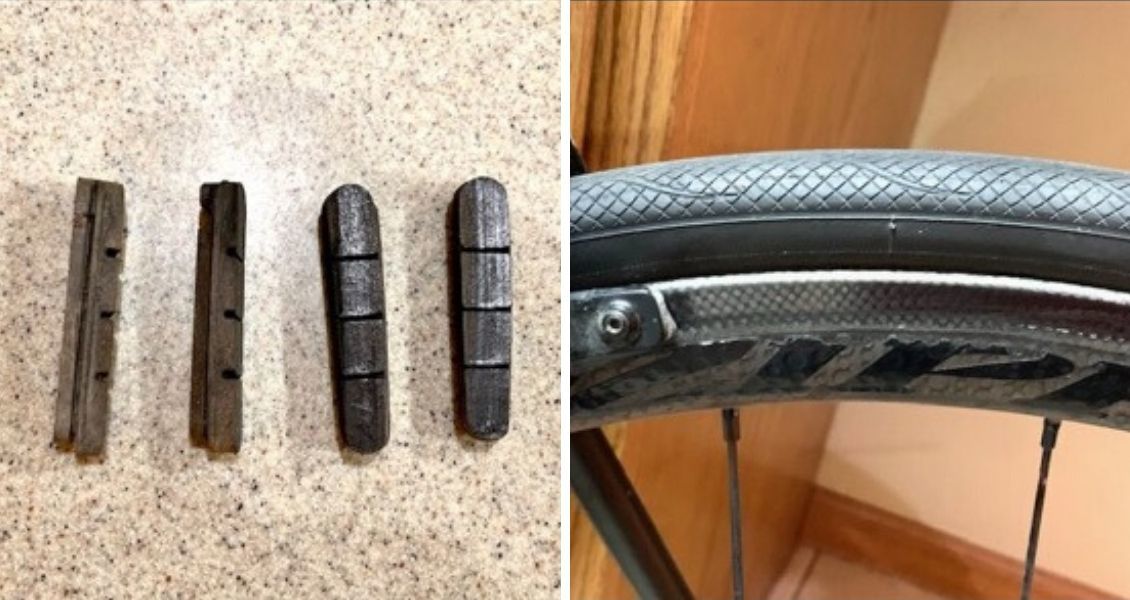I recently found that I had run my brake pads far too long without a real inspection this winter. Not good! I had been unhappy with my breaking on descents for a couple of months. I had looked at the “wear limit” grooves and noted plenty of wear left. (See the notches in the far left pad.) So, I rode on.

I finally pulled my wheels and inspected the breaking surfaces. They were totally cooked. [Photo (1) See the right two pads.] Like stone. What was I thinking? Dangerous and damaging. Months ago, I may have been able to freshen up the surfaces with sandpaper and salvage these pads. Not now, not at all. Inspection in the winter months is especially important due to the dirt, grit and moisture on the roads.
Also, I could have damaged my prized Zipp 202’s. [See photo (2)]. It appears the pads were riding a little low; still, they were within the braking area, but wearing off a slight strip of the decals. Completely uncalled for. Lesson learned: use your knowledge and inspect; you can use knowledge and keep it, too.

After getting the correct pads from our team shop, I installed them, adjusted the position, and cleaned the rims’ braking surfaces with alcohol. [See photo (3)]. I also toed them slightly inward.
The easiest way to position the brake shoe with the pad in it is to have someone hold the brake lever while you position the pad exactly where you want it. Then with them squeezing firmly on the lever, tighten the 4 mm break shoe bolt [shown in photos (3) and (5)] firmly. Otherwise, it’s difficult to position the pad and tighten at the same time.
You may need to “toe-in” your brake shoes so the front of the pads contact the braking surface first, to reduce noise and optimize even pressure. After firmly fixing your brake shoes in the proper path, again have someone assist by operating the levers. Place a credit card under the trailing 1/3 of the pad,
[See Photo (5) above]. Then, while the lever is squeezed firmly, loosen, then retighten the 4 mm brake shoe bolt. When the card is removed you should see a very slight taper of the pad in the front toward the rim. Please look this up on Park Tools website for more information on the subject.
With aluminum rims all this may not be as critical as with carbon rims, but it’s still important to inspect and maintain or replace pads. Aluminum rims can actually wear thin and cause repetitive flats or, worse, catastrophic failure when braking. Some rims have “dimples”, small holes drilled into the braking surface, to show wear. Otherwise have aluminum rim thickness measured with a micrometer at your bike shop.
Inspecting brake pads can be done by checking the wear grooves while the wheels are on the bike. [See photo (4) with the grove pointed out by the pencil.] But, as I found out, inspecting the surfaces is critical. You just need to remove your wheels. (See the same photo, center pad).
In this case, resurfacing and truing the pads with 150 grit sandpaper on a flat surface was all that was needed. (The topmost pad on the photo). However, these pads need replacing soon.
Really, it only takes a few minutes to inspect the pads. Maybe do it now. Spring is a good time to make an appointment and take your bike by your shop for a checkup/tune up, and mentioning your brake pads.
About The Contributor
Ed Shaw is a USA Cycling Level 3 Cycling Coach from Fort Collins, Colorado. He races for Team Rio Grande Racing in the Masters Age Group 70+. He likes to climb and race time trial. He loves to help riders accomplish something they didn't think they could do like climbing better, completing a tour, racing or just enjoying their bike more. He specializes in annual training plans associated with those goals. For more information contact Ed at 970-443-0352 or amleds@comcast.net.

